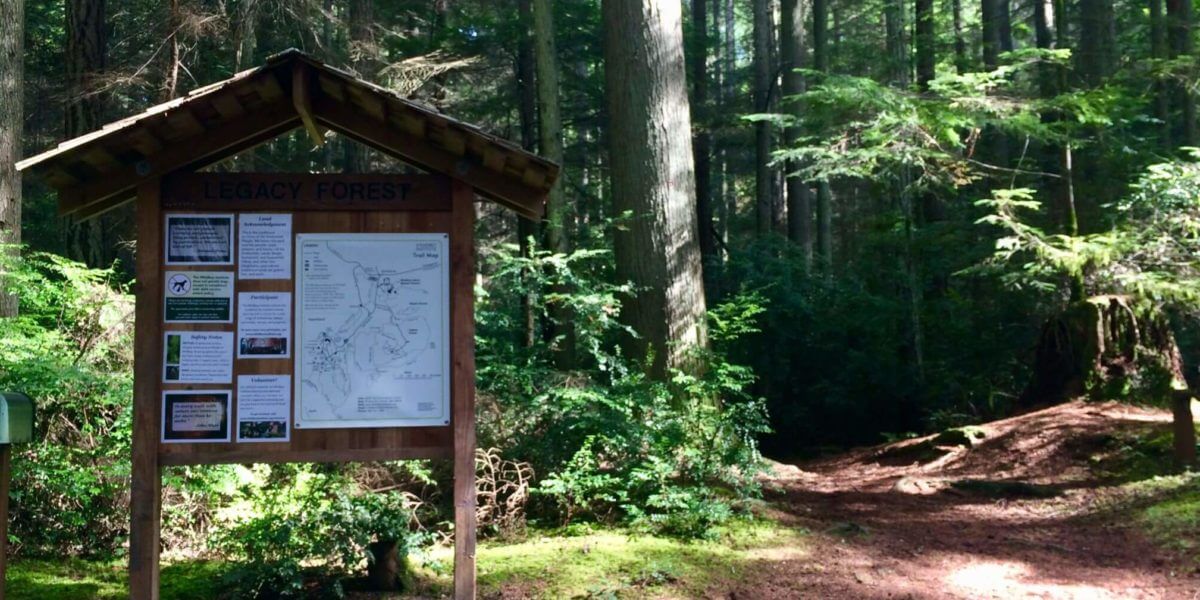Hiking Close to Home, a new guidebook from local author Maribeth Crandell with Jack Hartt, features trails at the Whidbey Institute as well as trails throughout Whidbey, Fidalgo and Guemes Islands.
The book was conceived after Maribeth was asked to prepare a presentation on local hikes for the library. “Every time I offered the presentation, people would come up and say, ‘what about this hike? What about that one? This expanded my perspectives and got me digging, learning about more hikes.” Now, with over 50 hikes in their newest book, Maribeth and Jack have traveled on foot all around Whidbey and the surrounding areas. “We’re revising the book because we’re almost sold out,” she told me. “Our new batch will be ready in February and will include 61 hikes.” Maribeth added that it will be featured at the Sound Waters Conference on February 1.
Maribeth said the book is geared for people of varying activity levels. The book has been designed to be easy to read and use, with each hike laid out on a spread: pictures and descriptions on one page and a map and directions on the other. There’s information on which hikes are accessible by bus, for folks who don’t drive or wish to reduce their carbon footprints, and are listed by ability level. Maribeth said most are easy, some are moderate, and a few are challenging. She also includes a list of accessible trails. For animal appreciators, the guide includes information about what trails are appropriate for on- or off-leash dogs and which trails are particularly good for birdwatching.
“It’s a good guide for people who can’t get up to the mountains, or who want to take a daily hike without a major expedition,” Maribeth said. “You can do these hikes all year round, though you do have to check tide tables for some of the beach walks.”
Maribeth’s book is available at Moonraker and South Whidbey Commons in Langley, Kingfisher Bookstore in Coupeville, Wind and Tide Books in Oak Harbor, and both Fort Casey and Fort Ebey state park gift shops. It’s also available at hikingclosetohome.weebly.com, where Maribeth and Jack post a weekly hike with photos from the trail plus information on trail events and beach clean-ups.
About the trails in the guide, Maribeth said, “each one has its own tone—a feeling, or a quality.” She said the trails at the Whidbey Institute have a feeling that’s very different from some other places on Whidbey, and are interesting enough to explore for an hour or a whole weekend.
Maribeth’s relationship with this land goes back to 1978, when she moved to Whidbey from North Carolina via the Olympic Peninsula and met Appletree Garden Steward Wilma O’Nan. “She became my west coast mom,” Maribeth said. “I learned a lot about gardening from her.” Maribeth even lived on the land here for a while, dwelling in the Hull Cabin and earning the informal title “exterior decorator” for her work in the gardens and trails. “We had bats in the belfry there,” she said. “I got rid of them by playing Joni Mitchell really loud—they didn’t like the high notes.”
Maribeth’s love of hiking started during childhood. Her parents took her hiking in 45 states, and she finished the rest of the states as an adult: attending a wedding in Hawaii, working as a naturalist and trail guide in Oregon, Washington, and Alaska, and birdwatching in North Dakota last of all. She hiked the Appalachian Trail in 2006 and wrote Flip Flop on the Appalachian Trail about her experience. Her co-author, Jack Hartt, worked 40 years in Washington State Parks, lastly as the manager of Deception Pass State Park. He retired and became involved in the Skagit Land Trust and Anacortes Community Forest Lands.
When asked if she has advice on how a newcomer to these woods can engage, she said, “try to sit quietly by yourself and listen. If you do that every day in the same place, you get to know the wildlife and they get to know you. You get to see a lot of things that you wouldn’t see if you were talking with a friend or walking a dog.” She told the story of a backpacking trip this summer, when she saw a shade of brown in a meadow that just didn’t fit in. “It looked like a rock,” she said. “I got up on my tiptoes and saw that it was a young elk, laying down and being still.”
Our conversation ended with Maribeth’s reflections on how important land conservation is. “These trails would not be here without the organizations, like the Whidbey Institute, that have acquired the land.There are lots of ways people can help with trails—contribute money, contribute time and energy, work in an office to help coordinate a trail work day, take photos and contribute to a calendar, or help generate interest.” She recommends reaching out directly to organizations like Whidbey Camano Land Trust that steward trails, and added that these organizations are listed in the guidebook.
Check out Maribeth’s 11/27/19 Hike of the Week: Whidbey Institute

